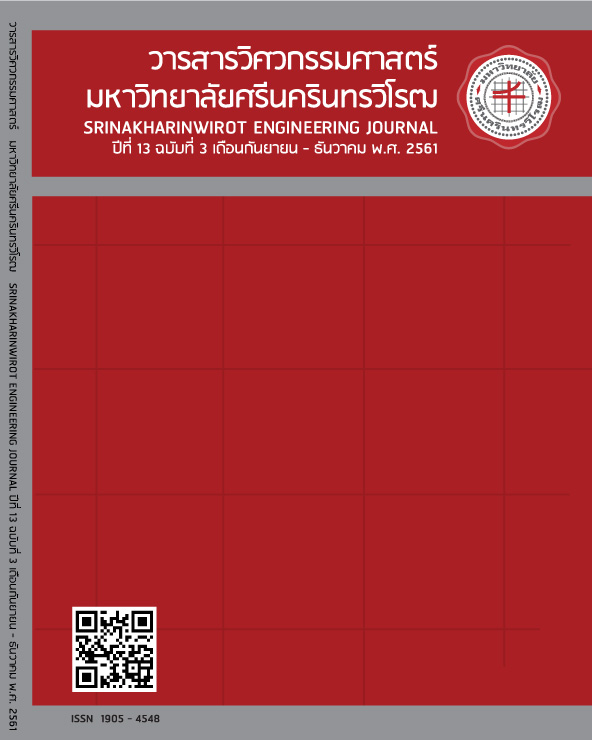Development of Hybrid Choice Models for Modal Shift Study: A Case Study of MRT Green Line Extension Kasetsart University Station
Main Article Content
Abstract
This research is aimed at developing a hybrid choice model to forecast the proportion of modal shift from private car to mass rapid transit (MRT) with either campus feeder buses or motorcycle taxis as egress modes of commuting trips to Kasetsart University. A survey of stated preference and factor scoring of four latent factors including convenience, comfort, safety and reliabilities are conducted. The results show that the newly developed hybrid choice model which integrates the traditional modal choice model with the MIMIC model can provide more accurate forecasting results than the traditional one that considering only travel time and cost subject to the increase of McFadden’s R-Square statistics by 4.03% and 3.26%, respectively where the precision of model predictions is increased by 0.74% and 0.68%, respectively.
Article Details
Copyright belongs to Srinakharinwirot University Engineering Journal
References
[2] M. E. Ben-Akiva and S. R. Lerman, Discrete Choice Analysis: Theory and Application to Travel Demand. Cambridge: MIT Press, 1985.
[3] W. Rujopakarn, Urban Transportation Planning. Bangkok: Kasetsart University, 2001. [in Thai]
[4] D. McFadden, “Quantitative methods for analyzing travel behaviour on individuals: some recent developments,” in Behavioural Travel Modelling, D. A. Hensher and P. R. Stopher, and C. Helm, Eds. London: Croom Helm, 1978, pp. 279-318.
[5] J. D. D. Ortuzar and L. G. Willumsen, Modelling Transport, 4th ed. Hoboken, NJ: John Wiley & Sons, 2011.
[6] C. Spearman, “General intelligence, objectively determined and measured,” American Journal of Psychology, vol. 15, no. 2, pp. 201-293, April 1904. [Online]. Available: JSTOR, https://www.jstor.org/
stable/1412107. [Accessed May. 1, 2018].
[7] S. Wright, “The method of path coefficients,” The Annals of Mathematical Statistics, vol. 5, no. 3, pp. 161-215, September 1934. [Online]. Available: JSTOR, https://www.jstor.org/stable/2957502. [Accessed May. 1, 2018].
[8] K. A. Bollen, Structural Equations with Latent Variables. Hoboken, NJ: John Wiley & Sons, 1989.
[9] B. E. Kline, Principles and Practice of Structural Equation Modelling, 3rd ed. New York: The Guilford Press, 2011.
[10] J. F. Hair, B. J. Banbin, R. E. Anderson, and W. C. Black, Multivariate Data Analysis, 7th ed. New Jersey: Pearson Prentice Hall, 2013.
[11] K. Vanichbancha, Structural Equation Modelling with AMOS. Bangkok: Samlada Partnership Limited, 2014. [in Thai]
[12] S. Piriyawat, Structural Equation Modelling and Travel Behaviour Study. Chonburi: Burapha University, September 2010. [in Thai]. [Online]. Available: https://www.surames.com/images/column_1227454930/SEMandTransportStudy.pdf. [Accessed May. 1, 2018].
[13] N. Wiratchai, LISREL Model: Statistical Analysis for Research, 3rd ed. Bangkok: Chulalongkorn University Printing Office, 1999. [in Thai]
[14] A. M. Anwar, A. K. Tieu, P. Gibson, M. J. Berryman, K. T. Win, A. McCusker, and P. Perez, “Temporal and parametric study of traveller preference heterogeneity using random parameter logit model,” International Journal for Traffic and Transport Engineering, vol. 4, no. 4, pp. 437-455, 2014.
[15] J. F. Hair, W. C. Black, B. J. Banbin, R. E. Anderson, and R. L. Tatham, Multivariate Data Analysis. 6th ed. New Jersey: Pearson Prentice Hall. 2006.
[16] M. E. Ben-Akiva, J. Walker, A. T. Bernardino, D. A. Gopinath, T. Morikawa, and A. Polydoropoulou, “Integration of Choice and Latent Variable Models,” October 1999. Available: https://www.joanwalker.com/uploads/3/6/9/5/3695513/benakivawalkeretal_iclv_chapter_2002.pdf. [Accessed May. 1, 2018].
[17] M. E. Ben-Akiva, D. McFadden, K. Train, J. Walker, C. Bhat, M. Bierlaire, D. Bolduc, A. Boersch-Supan, D. Brownstone, D. S. Bunch, A. Daly, D. Gopinath, A. Karlstrom, and M. A. Munizaga, “Hybrid choice models: progress and challenges,” Marketing Letters, vol. 13, no. 3, Choice Modeling, pp. 163-175, August 2002. [Online]. Available: Springer, https://www.jstor.org/stable/40216632. [Accessed May. 1, 2018].
[18] J. Kim, S. Rasouli, and H. Timmermans, “Hybrid choice models: Principles and recent progress incorporating social influence and nonlinear utility functions,” Procedia Environmental Sciences, Vol. 22, pp. 20-34, 2014.
[19] T. Yamane, Statistics: An Introductory Analysis, 2nd ed. New York: Harper and Row, 1967.
[20] L. Eboli and G. Mazzulla, “Performance indicators for an objective measure of public transport service quality,” European Transport\Trasporti Europri, vol. 51, pp. 1-4, 2012.
[21] K. Vanichbancha, Data Analysis with SPSS for Windows, 11th ed. Bangkok: Dharmasarn Printing Company Limited, 2008. [in Thai]
[22] A. P. Field, Discovering Statistics Using SPSS, 2nd ed. London: Sage, 2005.


